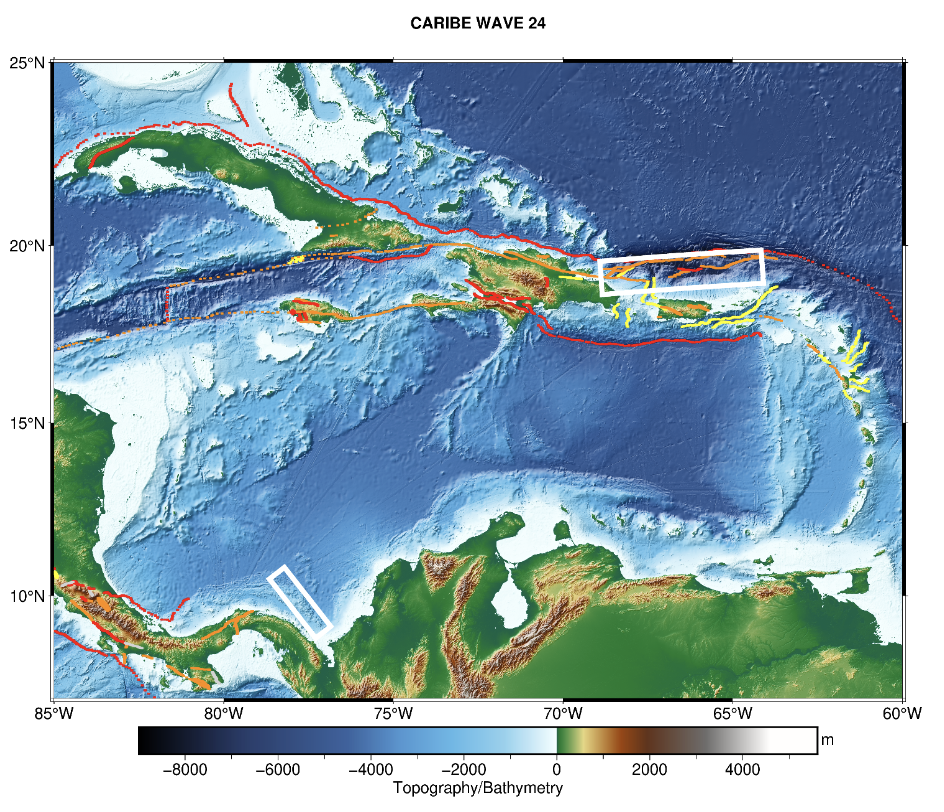CARIBE WAVE is the annual tsunami exercise of the Intergovernmental Coordination Group for the Tsunami and Other Coastal Hazards Warning System for the Caribbean and Adjacent Regions (ICG/CARIBE-EWS) of the Oceanographic Commission (IOC) of the United Nations Educational, Scientific, and Cultural Organization (UNESCO).
Who organizes CARIBE WAVE?
A CARIBE EWS CARIBE WAVE task team is responsible for the overall conduct of the exercise. The NOAA/UNESCO IOC International Tsunami Information Center Caribbean Office (ITIC-CAR) serves as exercise coordinator with the Caribbean Tsunami Information Center (CTIC). Regional emergency management stakeholders (CEPREDENAC [Coordination Centre for the Prevention of Natural Disasters in Central America], CDEMA [Caribbean Disaster Emergency Management Agency], and EMIZA [French Inter-Ministerial for the Antilles Estate Major Zone]) also contribute to the successful conduct of the exercise.
What is the purpose of CARIBE WAVE?
The purpose of this exercise is to validate and advance tsunami preparedness efforts in the Caribbean and Adjacent Regions.
When is CARIBE WAVE 2024?
The annual Tsunami Regional Exercise, CARIBE WAVE 2024, will take place on March 21, starting at 1500 UTC. You can register here.
Which scenario will be used for CARIBE WAVE 2024?
Two different scenarios will be simulated for CARIBE WAVE 2024. Each participating country will select the scenario that best fits their objectives. The first scenario simulates a tsunami generated by a magnitude 8.7 earthquake located in the Puerto Rico Trench. The second scenario simulates a tsunami caused by a magnitude 8.47 earthquake located on the Northern Panama Deformed Belt.
EN – UNESCO/IOC Caribe Wave Exercise – Video prepared by ITIC-CAR. View on Youtube.
Preparing for tsunami risk in the Caribbean – a video about the annual regional CARIBE WAVE Exercise prepared by UNESCO/IOC in collaboration with UNDRR. Can be viewed on YouTube.
Why should I participate in this exercise each year?
High levels of vulnerability and risk to life and livelihoods from tsunamis along the coasts of the Caribbean and Adjacent Regions should provide a strong incentive for countries and local jurisdictions to prepare for a tsunami and participate in this exercise. Over time, emergency response plans are updated and new personnel are integrated into tsunami operations, which provides a good opportunity to become familiarized, review and test current procedures.
What communication systems are tested in this exercise?
The communications between the Pacific Tsunami Warning Center (PTWC) and the Tsunami Warning Focal Points (TWFPs) and National Tsunami Warning Centers (NTWC) will be tested. Each country and territory decide if and how messages are disseminated within its area of responsibility. For Central America countries, the Central America Tsunami Advisory Center (CATAC) will be issuing the messages for the Panama scenario.
Which agencies participate in this exercise?
Each one of the 48 countries and territories that are members of CARIBE EWS decide on the level of participation and coordinate the corresponding activities within their jurisdiction. All officially designated CARIBE EWS National Tsunami Warning Focal Points and Warning Centers will receive products from the PTWC.
The exercise guidelines, other related materials and links for registration and evaluation are available from the ITIC CARIBE WAVE 2024 webpage.
How do I register my participation for CARIBE WAVE 2024?
Click “register” at the top left of this page or head directly to the registration page.
UNESCO CARIBE EWS Member States and Territories
*not an IOC Member State
**Designations of Tsunami National Contacts and Tsunami Warning Focal Points pending
***UNESCO Associate Member States participating at IOC CARIBE EWS
Observer Member States of UNESCO CARIBE EWS
| Canada | Peru |


